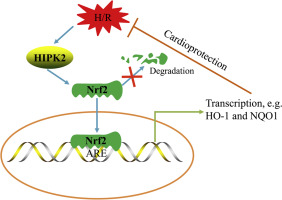当前位置:
X-MOL 学术
›
Chem. Biol. Interact.
›
论文详情
Our official English website, www.x-mol.net, welcomes your
feedback! (Note: you will need to create a separate account there.)
HIPK2 overexpression relieves hypoxia/reoxygenation-induced apoptosis and oxidative damage of cardiomyocytes through enhancement of the Nrf2/ARE signaling pathway.
Chemico-Biological Interactions ( IF 4.7 ) Pub Date : 2019-12-16 , DOI: 10.1016/j.cbi.2019.108922 Xiaoyan Dang 1 , Rui Zhang 1 , Zhuo Peng 1 , Yong Qin 2 , Jiangli Sun 1 , Zequn Niu 1 , Honghong Pei 1
Chemico-Biological Interactions ( IF 4.7 ) Pub Date : 2019-12-16 , DOI: 10.1016/j.cbi.2019.108922 Xiaoyan Dang 1 , Rui Zhang 1 , Zhuo Peng 1 , Yong Qin 2 , Jiangli Sun 1 , Zequn Niu 1 , Honghong Pei 1
Affiliation

|
Homeodomain interacting protein kinase-2 (HIPK2) has emerged as a crucial stress-responsive kinase that plays a critical role in regulating cell survival and apoptosis. However, whether HIPK2 participates in regulating cardiomyocyte survival during myocardial ischemia/reperfusion injury remains unclear. Here, we investigated the regulatory effect of HIPK2 on hypoxia/reoxygenation (H/R)-induced cardiomyocyte injury and its potential underlying molecular mechanism. We found that HIPK2 expression was induced in response to H/R exposure. HIPK2 depletion by small interfering RNA (siRNA)-mediated gene silencing significantly decreased the viability and exacerbated H/R-induced apoptosis and reactive oxygen species (ROS) production in cardiomyocytes. Comparatively, HIPK2 overexpression effectively rescued H/R-impaired viability and repressed H/R-induced apoptosis and ROS production in cardiomyocytes. HIPK2 overexpression significantly increased the nuclear expression of nuclear factor (erythroid-derived 2)-like 2 (Nrf2) and enhanced Nrf2-mediated transcriptional activity. Moreover, HIPK2 overexpression significantly increased the transcription of Nrf2/ARE target genes. Additionally, Nrf2 inhibition partially reversed the HIPK2-mediated protective effect. Overall, these results demonstrate that HIPK2 overexpression protects cardiomyocytes from H/R-induced injury by enhancing Nrf2/ARE antioxidant signaling, data that suggest HIPK2 is a potential target for cardioprotection.
中文翻译:

HIPK2过表达通过增强Nrf2 / ARE信号通路来缓解缺氧/复氧诱导的心肌细胞凋亡和氧化损伤。
同源结构域相互作用蛋白激酶2(HIPK2)已成为一种重要的应激反应激酶,在调节细胞存活和凋亡中起着至关重要的作用。但是,HIPK2是否参与心肌缺血/再灌注损伤期间心肌细胞存活的调节尚不清楚。在这里,我们研究了HIPK2对缺氧/复氧(H / R)诱导的心肌细胞损伤的调节作用及其潜在的潜在分子机制。我们发现,HIPK2表达被诱导响应H / R暴露。小分子干扰RNA(siRNA)介导的基因沉默导致HIPK2耗竭显着降低了心肌细胞的活力,并加剧了H / R诱导的凋亡和活性氧物质(ROS)的产生。比较,HIPK2过表达有效地挽救了H / R受损的生存力,并抑制了H / R诱导的心肌细胞凋亡和ROS产生。HIPK2过表达显着增加了核因子(类胡萝卜素衍生的2)样2(Nrf2)的核表达,并增强了Nrf2介导的转录活性。此外,HIPK2过表达显着增加了Nrf2 / ARE靶基因的转录。此外,Nrf2抑制部分逆转了HIPK2介导的保护作用。总体而言,这些结果表明,HIPK2过表达可通过增强Nrf2 / ARE抗氧化剂信号传导来保护心肌细胞免受H / R诱导的损伤,这些数据表明,HIPK2是心脏保护的潜在靶标。HIPK2过表达显着增加了核因子(类胡萝卜素衍生的2)样2(Nrf2)的核表达,并增强了Nrf2介导的转录活性。此外,HIPK2过表达显着增加了Nrf2 / ARE靶基因的转录。此外,Nrf2抑制部分逆转了HIPK2介导的保护作用。总体而言,这些结果表明,HIPK2过表达可通过增强Nrf2 / ARE抗氧化剂信号传导来保护心肌细胞免受H / R诱导的损伤,这些数据表明,HIPK2是心脏保护的潜在靶标。HIPK2过表达显着增加了核因子(类胡萝卜素衍生的2)样2(Nrf2)的核表达,并增强了Nrf2介导的转录活性。此外,HIPK2过表达显着增加了Nrf2 / ARE靶基因的转录。此外,Nrf2抑制部分逆转了HIPK2介导的保护作用。总体而言,这些结果表明,HIPK2过表达可通过增强Nrf2 / ARE抗氧化剂信号传导来保护心肌细胞免受H / R诱导的损伤,这些数据表明,HIPK2是心脏保护的潜在靶标。
更新日期:2019-12-17
中文翻译:

HIPK2过表达通过增强Nrf2 / ARE信号通路来缓解缺氧/复氧诱导的心肌细胞凋亡和氧化损伤。
同源结构域相互作用蛋白激酶2(HIPK2)已成为一种重要的应激反应激酶,在调节细胞存活和凋亡中起着至关重要的作用。但是,HIPK2是否参与心肌缺血/再灌注损伤期间心肌细胞存活的调节尚不清楚。在这里,我们研究了HIPK2对缺氧/复氧(H / R)诱导的心肌细胞损伤的调节作用及其潜在的潜在分子机制。我们发现,HIPK2表达被诱导响应H / R暴露。小分子干扰RNA(siRNA)介导的基因沉默导致HIPK2耗竭显着降低了心肌细胞的活力,并加剧了H / R诱导的凋亡和活性氧物质(ROS)的产生。比较,HIPK2过表达有效地挽救了H / R受损的生存力,并抑制了H / R诱导的心肌细胞凋亡和ROS产生。HIPK2过表达显着增加了核因子(类胡萝卜素衍生的2)样2(Nrf2)的核表达,并增强了Nrf2介导的转录活性。此外,HIPK2过表达显着增加了Nrf2 / ARE靶基因的转录。此外,Nrf2抑制部分逆转了HIPK2介导的保护作用。总体而言,这些结果表明,HIPK2过表达可通过增强Nrf2 / ARE抗氧化剂信号传导来保护心肌细胞免受H / R诱导的损伤,这些数据表明,HIPK2是心脏保护的潜在靶标。HIPK2过表达显着增加了核因子(类胡萝卜素衍生的2)样2(Nrf2)的核表达,并增强了Nrf2介导的转录活性。此外,HIPK2过表达显着增加了Nrf2 / ARE靶基因的转录。此外,Nrf2抑制部分逆转了HIPK2介导的保护作用。总体而言,这些结果表明,HIPK2过表达可通过增强Nrf2 / ARE抗氧化剂信号传导来保护心肌细胞免受H / R诱导的损伤,这些数据表明,HIPK2是心脏保护的潜在靶标。HIPK2过表达显着增加了核因子(类胡萝卜素衍生的2)样2(Nrf2)的核表达,并增强了Nrf2介导的转录活性。此外,HIPK2过表达显着增加了Nrf2 / ARE靶基因的转录。此外,Nrf2抑制部分逆转了HIPK2介导的保护作用。总体而言,这些结果表明,HIPK2过表达可通过增强Nrf2 / ARE抗氧化剂信号传导来保护心肌细胞免受H / R诱导的损伤,这些数据表明,HIPK2是心脏保护的潜在靶标。











































 京公网安备 11010802027423号
京公网安备 11010802027423号